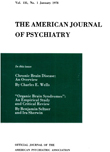THE USE OF SEPARATION AS A DIAGNOSTIC MEASURE IN THE PARENT-CHILD EMOTIONAL CRISIS
Abstract
As a result of these experiences, we are convinced that a valuable diagnostic tool has been overlooked in child psychiatry. We decided to set up an acute inpatient service for pre-adolescent, emotionally disturbed children, based on the notion that a short period of carefully structured separation at the time of a crisis may be a valuable diagnostic tool in permitting a more intensive and extensive evaluation of intrinsic problems in child and family. It should be emphasized that this notion does not negate the general principles of support for children to live in warm family relationships rather than apart from them. However, this notion does allow for exceptions to the rule; all children are not best off in their own families; structured and realistic separations are not inevitably traumatic and the door is open to the temporary separation of children with hospital placement as a relieving and elective diagnostic tool rather than inevitably as a last resort.
Access content
To read the fulltext, please use one of the options below to sign in or purchase access.- Personal login
- Institutional Login
- Sign in via OpenAthens
- Register for access
-
Please login/register if you wish to pair your device and check access availability.
Not a subscriber?
PsychiatryOnline subscription options offer access to the DSM-5 library, books, journals, CME, and patient resources. This all-in-one virtual library provides psychiatrists and mental health professionals with key resources for diagnosis, treatment, research, and professional development.
Need more help? PsychiatryOnline Customer Service may be reached by emailing [email protected] or by calling 800-368-5777 (in the U.S.) or 703-907-7322 (outside the U.S.).



